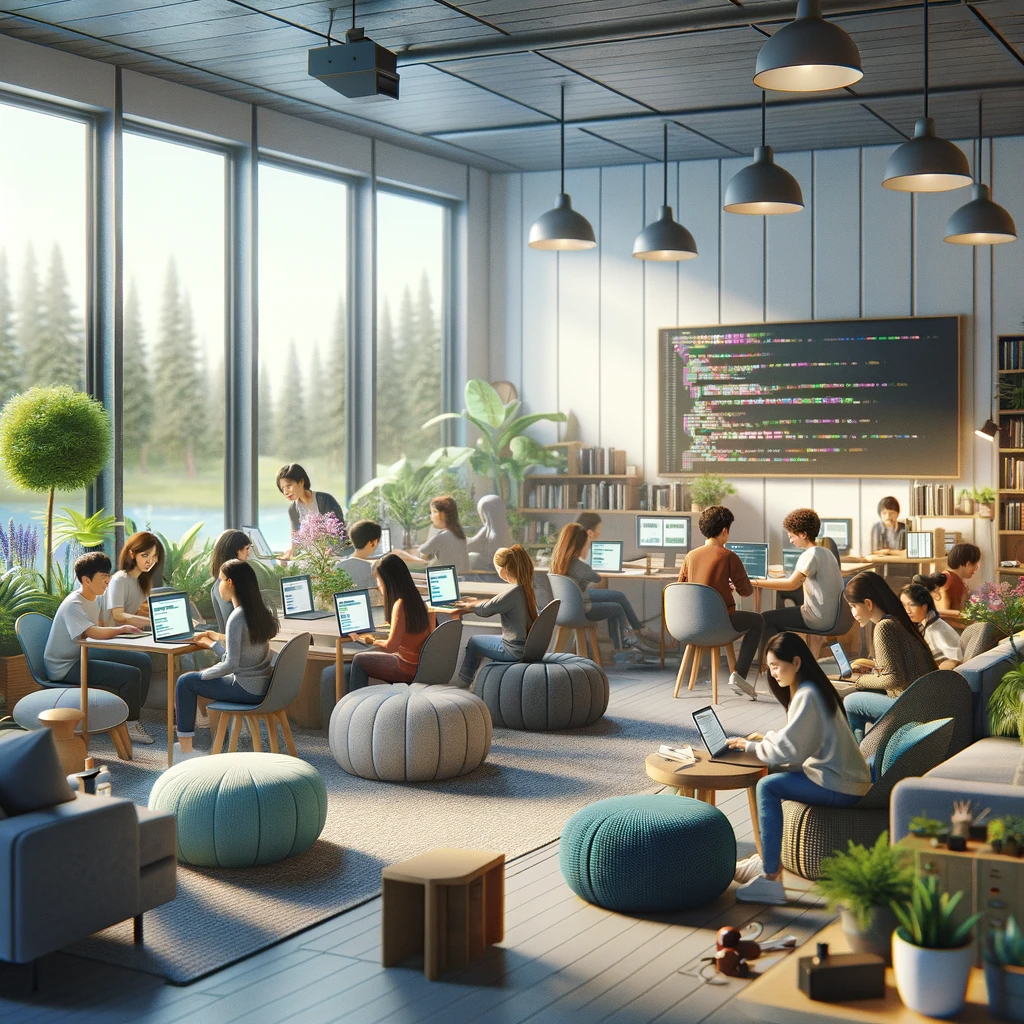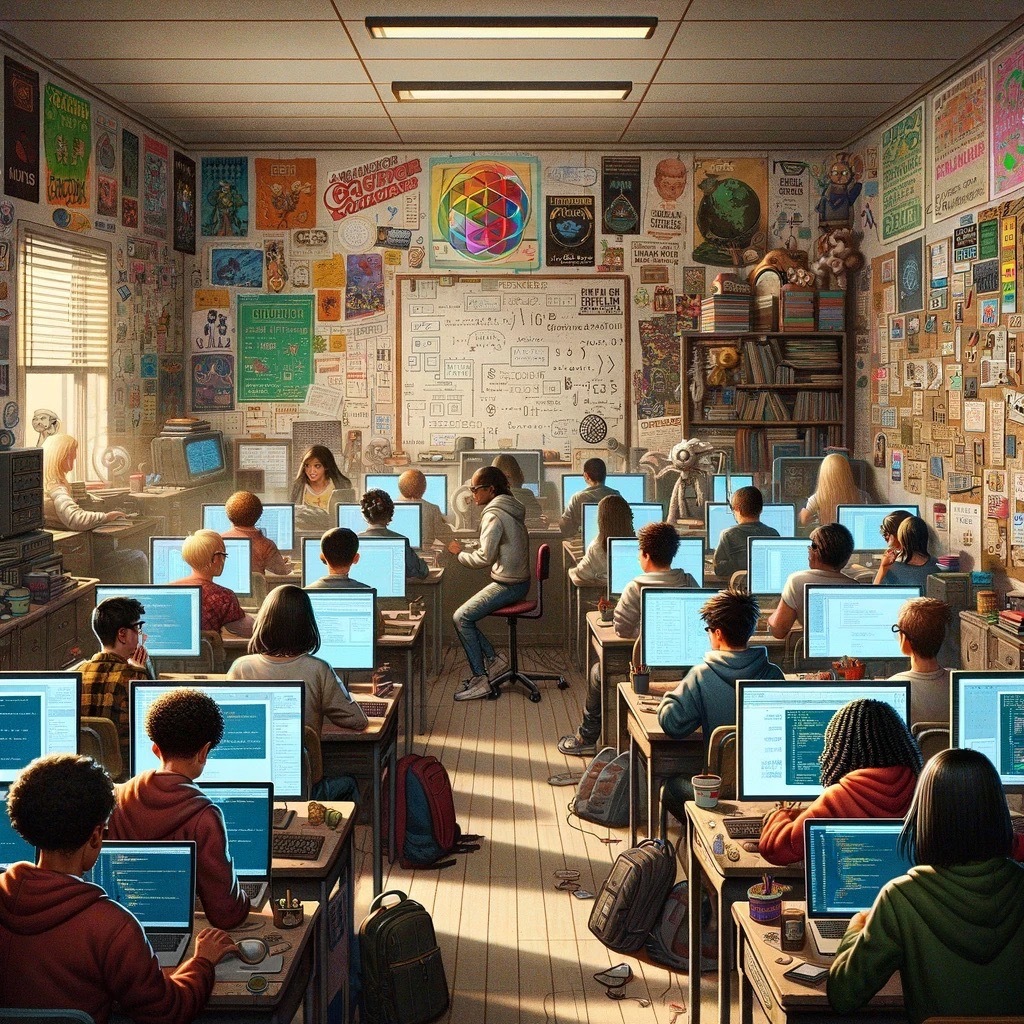Effective Classroom Environments for Learning Python: A Guide to Comfort and Engagement
Introduction
This two-part series explores the crucial role of environmental and cognitive processes in fostering positive learning experiences in computer science, specifically focusing on Python programming. Each part will offer actionable tips to create a thriving learning environment for your students.
Imagine these two classroom environments, both created in Dall-e. Which environment is more conducive to learning Python?


The Classroom Challenge
Traditional classroom settings can often pose obstacles to effective learning, particularly in dynamic subjects like coding. These limitations may include:
- Limited collaboration: Rows of desks restrict interaction and create a sense of isolation.
- Emphasis on quietness: The expectation of absolute silence can hinder the interactive nature of coding, hindering exploration and discussion.
- Uncomfortable seating: Traditional chairs often lack ergonomics, leading to physical discomfort and reduced focus.
Building a Better Environment
Extensive research in environmental design and cognitive science emphasizes the profound impact of comfort on learning, productivity, and creativity. By prioritizing comfort in your coding classroom, you can foster:
- Engagement: A welcoming and inclusive space encourages active participation and teamwork.
- Motivation: Reduced distractions and a comfortable environment allow students to focus on the learning process effectively.
- Well-being: Attention to physical and mental comfort promotes a positive learning experience.
Creating Comfort and Engagement: 10 Practical Tips
Build Community:
- Foster group seating by arranging furniture in smaller clusters within the classroom. This promotes a sense of connection, belonging, and emotional comfort.
- Encourage students to work together in these spaces, fostering collaboration and reducing feelings of isolation.
Teacher Location:
- Move beyond the traditional "sage on the stage" approach. Position yourself closer to students, fostering accessibility and encouraging active learning through discussions and collaborative activities. This proximity also helps break down traditional boundaries and promotes a more inclusive learning environment.
Comfortable Seating:
- Advocate for replacing traditional chairs with ergonomic options that provide better back and neck support, reducing fatigue and discomfort.
- Consider introducing floor seating options, like cushions or beanbags, to cater to individual preferences and learning styles. Remember, variety is key to ensure inclusivity.
Diverse Learning Areas:
- Create distinct spaces within the classroom to accommodate various activities, preferences, and learning styles. This could include dedicated areas for individual coding practice, group projects, focused learning, and group discussions.
- Designate a central space with a large rug or flexible seating arrangements for group discussions, code reviews, or brainstorming sessions.
- Provide movable chairs or stools to encourage flexibility during group work. Consider adding display screens for showcasing code or for better visibility.
Embrace the Outdoors:
- When possible, consider incorporating outdoor learning experiences for a change of pace and increased creativity. Explore opportunities to conduct certain activities outside or provide students with flexible options for individual work environments.
Control Acoustics:
- Minimize noise distractions by addressing potential sources like hard floors or walls.
- Use sound-absorbing materials like carpets, curtains, or acoustic panels to minimize noise bleed between different learning areas.
- Explore other options for damping sound and noise to create a more focused learning environment.Shelving with fabric storage boxes help minimize noise and provide orgranization.
Music and Productivity:
- Acknowledge that individual preferences for music vary. While not suitable for everyone, consider incorporating instrumental or focus music for specific coding tasks. Offer periodic breaks with uplifting music during these times. Remember, silence is still crucial for tasks requiring total concentration.
Cultivate a Positive Classroom Culture:
- Create a welcoming and inviting atmosphere by incorporating elements like plants or student artwork.
- Encourage a sense of ownership and responsibility by greeting students individually and involving them in room design and maintenance tasks.
Prioritize Air Quality:
- Ensure good indoor air quality by allowing fresh air into the room or using air purifiers. Fresh air is crucial for promoting alertness and focus, essential for mentally demanding tasks like coding.
- Bring in plants that are known for removing harmful chemicals and improving air quality by filtering out toxins like benzene, formaldehyde, and trichloroethylene. These "air-purifying plants" not only enhance the aesthetics of your classroom but also contribute to a healthier learning environment.
Minimize Overstimulation:
- Reduce potential distractions by carefully managing visual elements in the classroom. Ensure that any classroom displays are relevant to the current learning objectives and avoid unnecessary clutter.
Conclusion
By implementing these practical strategies, you can transform your coding classroom into a comfortable and engaging environment. This not only fosters positive learning experiences for your students but also empowers them to unlock their full potential in the exciting world of computer science.
Additional Resources
- The impact of classroom design on pupils' learning by P. Barrett et al. (2015)
- A Comfortable Truth: Well-Planned Classrooms Make a Difference by Edutopia (n.d.)
- Visual Environment, Attention Allocation, and Learning in Young Children by A. V. Fisher et al. (2014)
- The influence of indoor environmental factors on learning by Y.-K. Juan & Y. Chen (2022)
